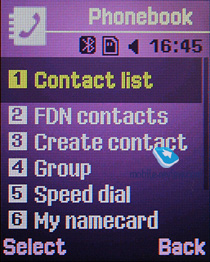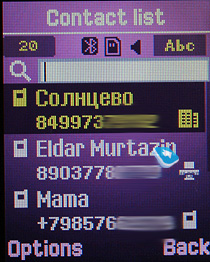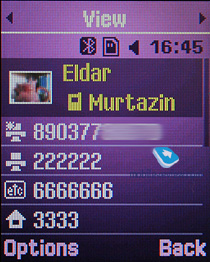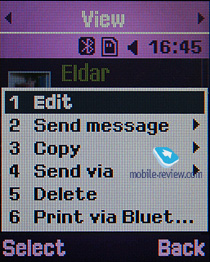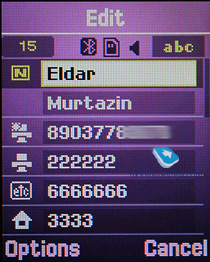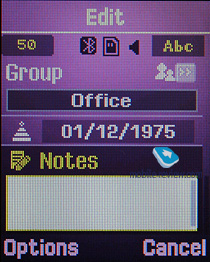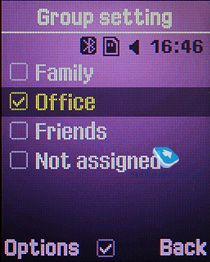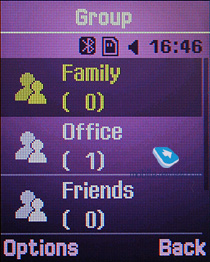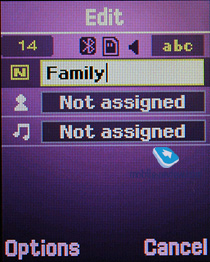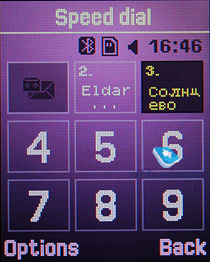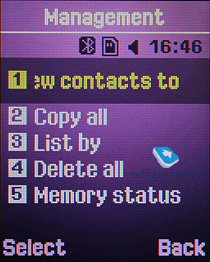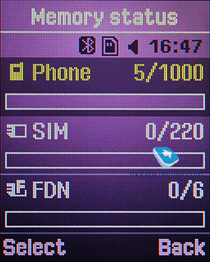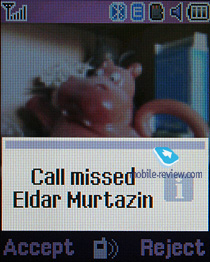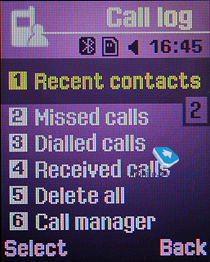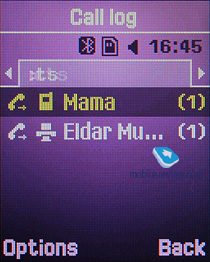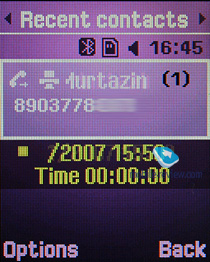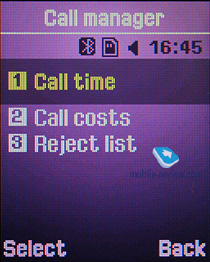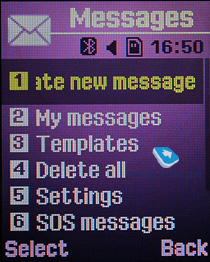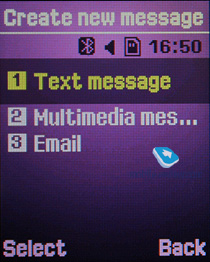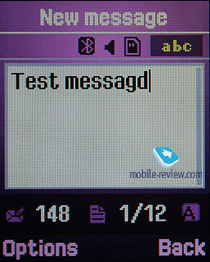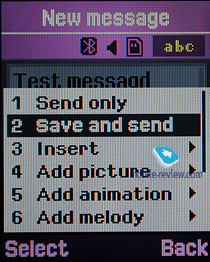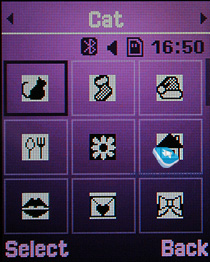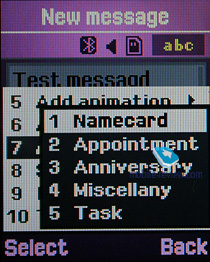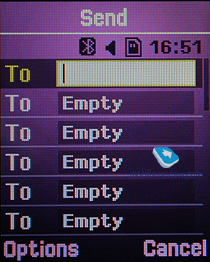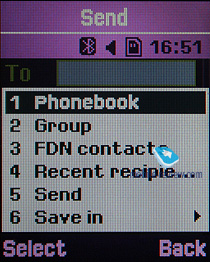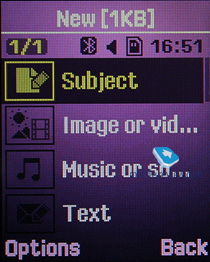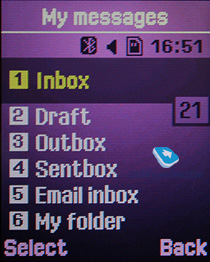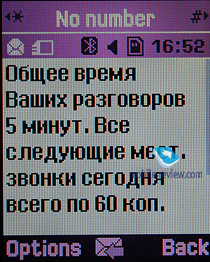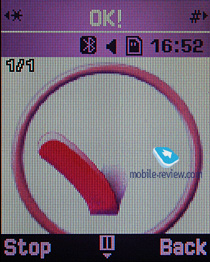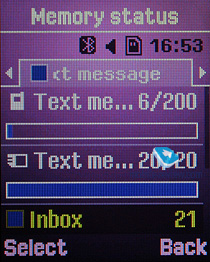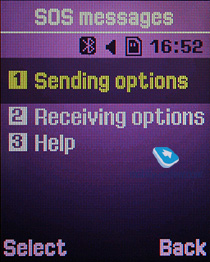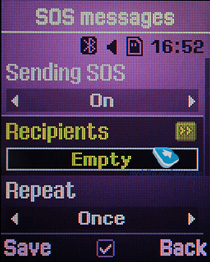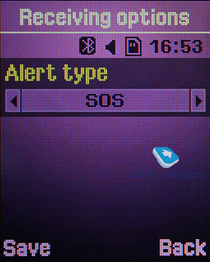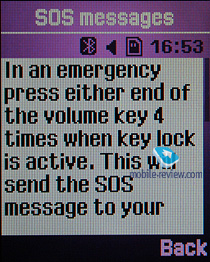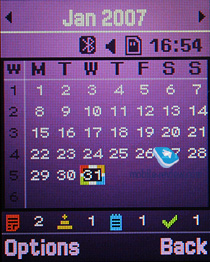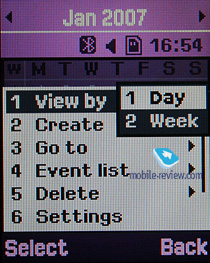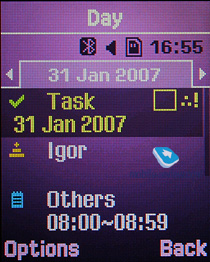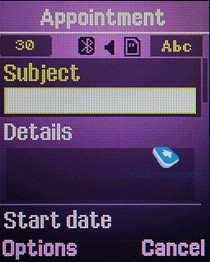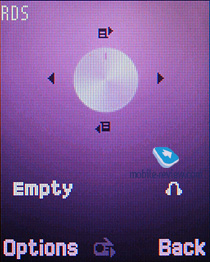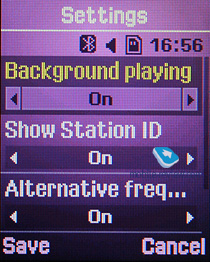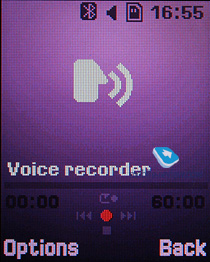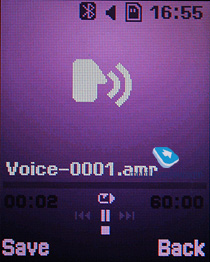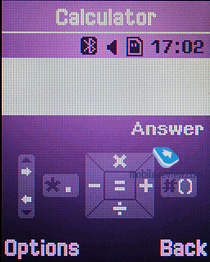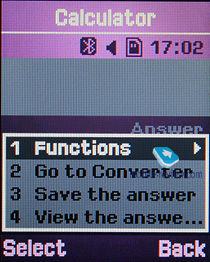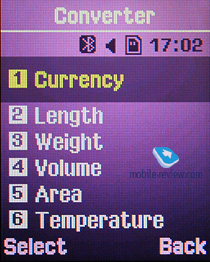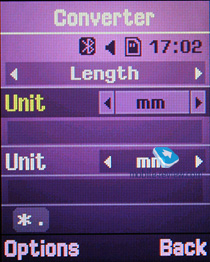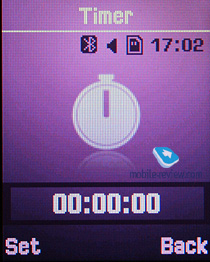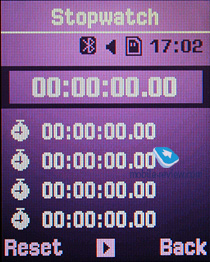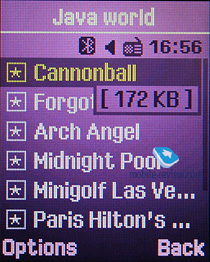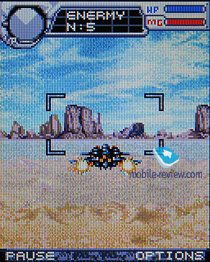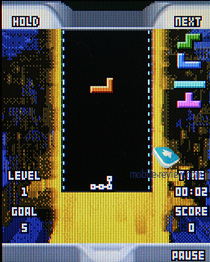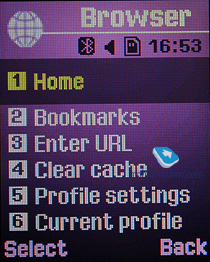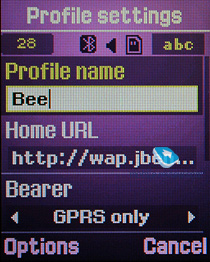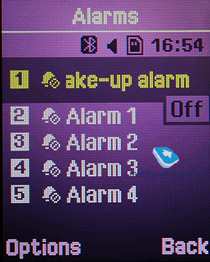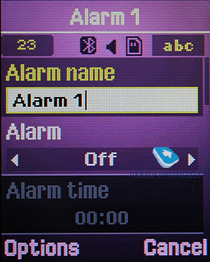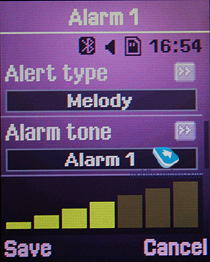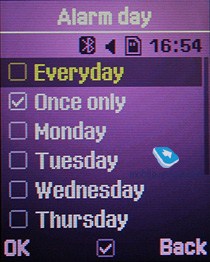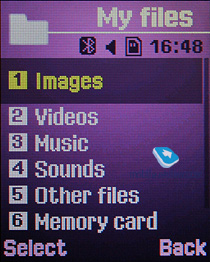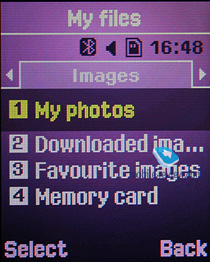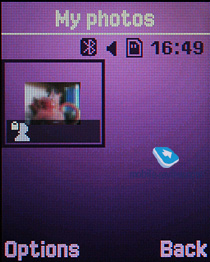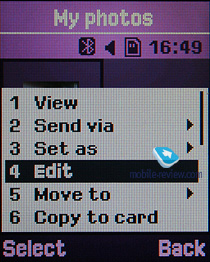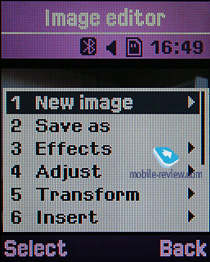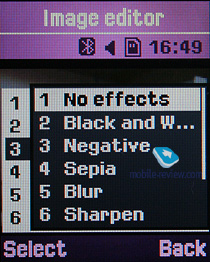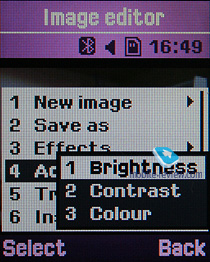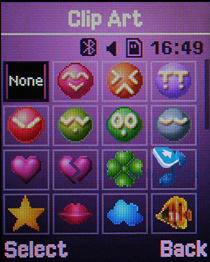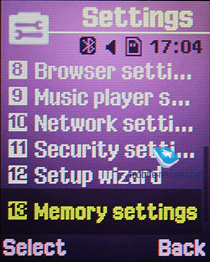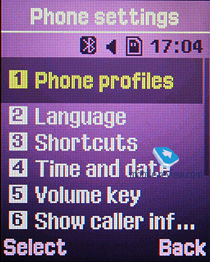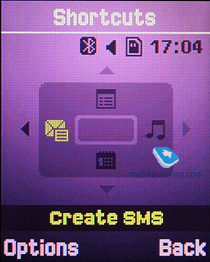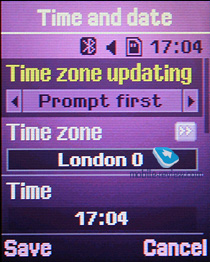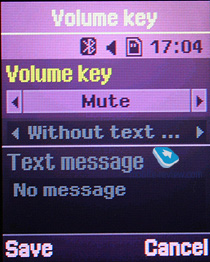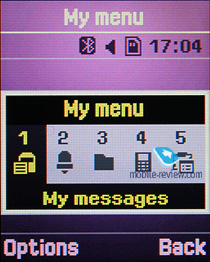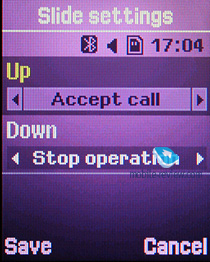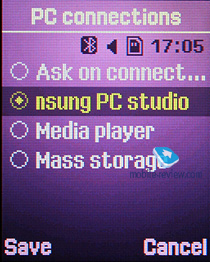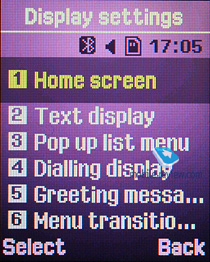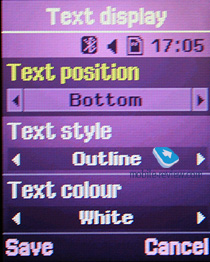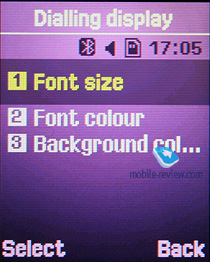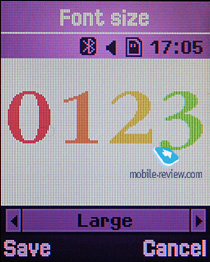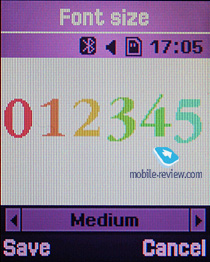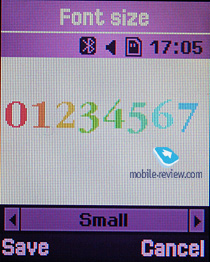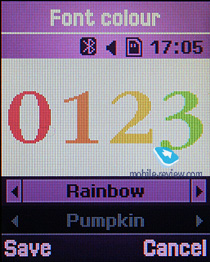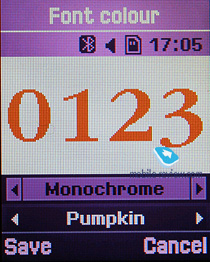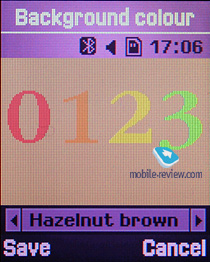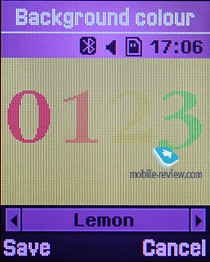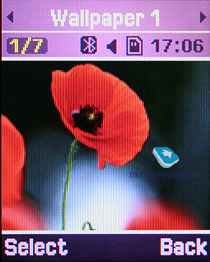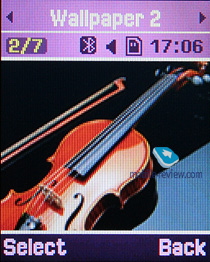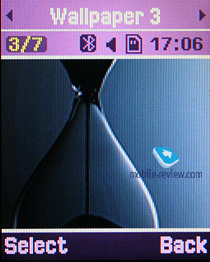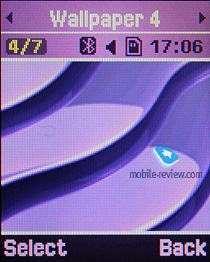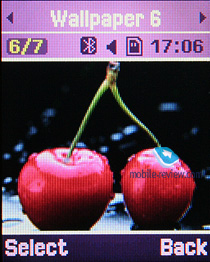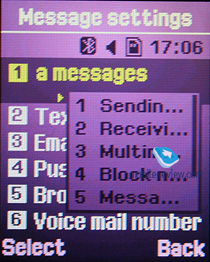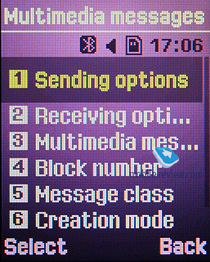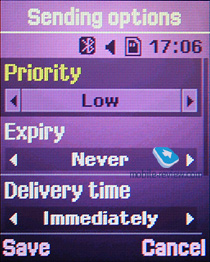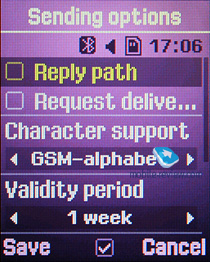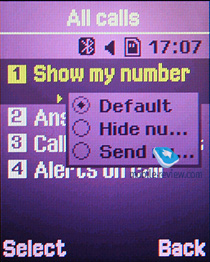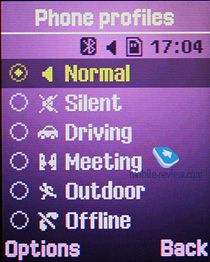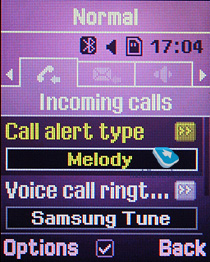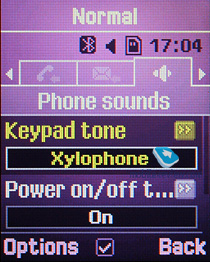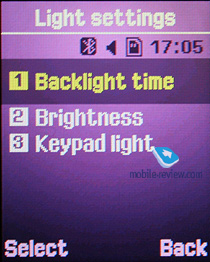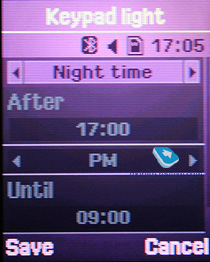Review of GSM-handset Samsung F250
Table of contents:
- Positioning
- Design, size, controls
- Display
- Keypad
- Battery
- Connectivity
- Memory, Memory Cards
- Performance
- Camera
- Menu
- Phonebook
- Call log
- Messaging
- Organizer
- FM-radio
- Applications
- WAP
- MP3-player
- Settings
- Impressions
Sales package:
- Handset
- Battery
- Charger
- Wired stereo-headset
- User Guide
- Software CD
- Wired speakers (only in the music-minded edition)
Positioning
The Samsung F250’s debut is an attempt to bring about a music-heavy entry-level offering. The maker’s marketers banked on the Samsung F330 as the primary force, however its sales were not quite what they had expected. The reason is that its design, functionality, price and competition were out of sync; that device was one mixed bag and therefore had very slim chances to appeal to the mass-market. When we first saw the pictures of the Samsung F250 it seemed that it was heavily influenced by the F330, but a closer inspection revealed that this was a mere illusion brought about mainly by the casing's mirrorish black coating. The fact is it’s really hard to confuse these two handsets in real life.

Samsung F250
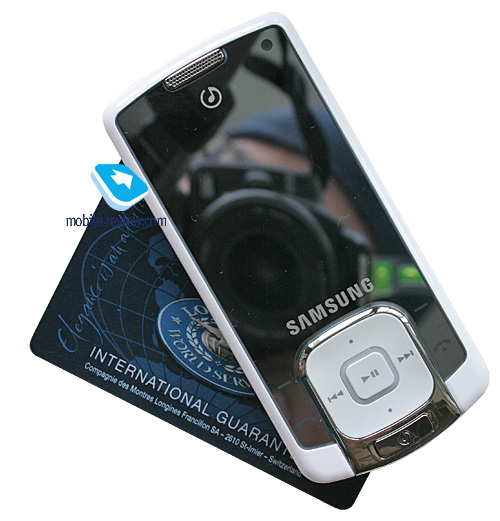
Samsung F330
It turns out that the F250 is a different creature, being the most affordable music playing offering from Samsung to date. Underscoring the latter fact they have even put a pair of wired speakers into the box, which is the move other manufacturers have tried, but it seems consumers don’t really appreciate this addition to sales packages. In Russia the F250 had initially been identified as the junior solution in the La’Fleur range, but two weeks into sales they started to make the difference between the feminine and music-savvy versions. This way, the former has fancy patterns on the back and the speakers omitted from the package; other than that, these two variants of the F250 are totally identical, that’s why it is no big deal to mistake the music edition for its look-a-like for women and that’s understandable.
Looking to compete with the Nokia 5300, the F250 offers a more no-nonsense design, and that’s why despite all similarities and parallels between the two, it is pretty challenging to compare them on a big scale. Having a broader and deeper target demographic than just youth alone (unlike Nokia’s offspring), Samsung can win over a lot more consumers, including those past their 30s, who will opt for the F250 in view of its conventional, unfussy design, coming in a variety of color schemes and boasting a 3.5 mm audio jack for good measure.
Back to the table of contents >>>
Design, size, controls
The handset measures in at 94x46x17 mm and weighing 81g, which is a fair bit thicker than Samsung’s slim sliders, but as far as the F250’s price bracket goes, this parameter is within the mark, no reason to deem it overly bulky. It is always nice when slim is in, but if it isn’t, then it is not a big issue either. The F250 is svelte enough to allow for any carrying method, including a lanyard – you will find an eyelet for it at the base.



The F250 comes in five flavors as of today, these are Brown Black, Candy Red, Caramel Orange, Coffee Brown, Ice Blue – all these trims differ only in the front fascia’s color.



The handset comes with a nice spring-loaded mechanism which makes the halves slide back and forth effortlessly. Unfortunately there is no thumbrest whatsoever, making the glossy front fascia even more of a fingerprint-magnet; although, for the most part, all smudges on it keeps low profile.



The left-hand side houses a standard 3.5 mm audio jack along with the volume rocker key. On the right are the dedicated music and camera buttons. Sitting right behind the plastic stub is the F250’s interface connector for plugging in a charger or headset. Finally, the back is home of the 1.3 Mpix camera’s lens.

Back to the table of contents >>>
Display
The handset comes armed with a 2 inch TFT display with a resolution of 128x160 pixels, which is, as far as the 200 USD price bracket is concerned, by no means contemporary – actually, QVGA screen no longer look like a privilege in this segment these days. The Samsung F250’s picture is not exactly bright and juicy, plus its low resolution doesn’t make for great-looking images or pictures. Nevertheless, if you have never had a phone with a better display, the F250’s unit will look just fine to you, but I doubt this will hold true for the vast majority of users.
The screen accommodates up to 6 text and 3 service lines, all written in a big and very readable font (which is also used for SMS and dialing display). The F250’s display remains legible in the sun, although gets washed out to a certain extent.
Back to the table of contents >>>
Keypad
We were happy to find out that there were no touch-sensitive controls employed in the F250, meaning that we didn’t have to look at the keypad to type a number or had any problems with dialing with gloves on, plus we appreciated the travel distance. The numberpad is housed on a plastic slab with all keys separated by tactile horizontal insets. All keys are lit in bright white which is well-visible in various environments.



Back to the table of contents >>>
Battery
The handset utilizes a 800 mAh Li-Ion battery. The manufacturer rates it as being good for up to 250 hours of standby and 2,5 hours of talk time. Within European networks the phone lasted around 2.5 days (one hour of calls total and three hours of music). At the same time, in Moscow it managed to stay online for 2 days at 1.5 hours of calls. Hence our guess that the F250 will last at least 2 days with average load, but 3 days of battery time are not unreachable. It takes the handset 1.5 hours to charge from empty to full. No higher-capacity cells are available for this model.


We got a shade more than 20 hours of continuous music with the F250 (radio part enabled), which is almost twice as long compared to Samsung’s previous solutions.
Back to the table of contents >>>
Connectivity
Bluetooth. The model supports various profiles, such as Headset, Handsfree, Serial Port, Dial Up Networking, File Transfer, Object Push, Basic Printing, A2DP, Dual Profile Bluetooth. The phone makes use of EDR-enabled Bluetooth 2.0. The way the F250 handles headsets doesn’t allow us to have any quibbles with it, everything is standard here. The F250 is one of Samsung’s first offerings to beam sound to two headsets simultaneously.
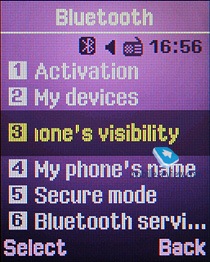
USB-connection. In the menu you may select one of three modes: Samsung PC Studio, Mass Storage, Media Player (MTP).
While in the USB Mass Storage mode, the F250 shows up on the desktop without requiring you to install any additional drivers, so right after plugging in it’s ready to work. Data connection speeds top out at 950 Kb/s.
You won’t be able to use the F250’s Bluetooth connectivity along with USB – it will require you to disable Bluetooth regardless of its status (connected and transferring data or not), which is very awkward.
For GSM networks, the F250 comes with EDGE class 10 data.
Back to the table of contents >>>
Memory, Memory Cards
The phone ships with 18.5 Mb of onboard memory – this storage space, give or take, is available to the user right out of the box. The memory card (not hot-swappable) is displayed as a separate section, so you can’t access both memory types at a time. The F250 also comes with a file manager, enabling you to copy files to/from the memory card. A sign of its low-tier origin is the memory card slot placed under the battery. In our test the handset had no problems handling a 2 Gb microSD memory card, whereas a 4 Gb unit remained unidentified.
Back to the table of contents >>>
Performance
The F250’s performance is very typical for the previous generation of Samsung’s phones, although for a product of this type it is nothing out of the ordinary. New applications can be uploaded only over the air (Wap); Java-apps are limited in size to 300 Kb. Compared to the Samsung L320, this phone is a worse performer on this front; what is more, it lacks support for some JSR.
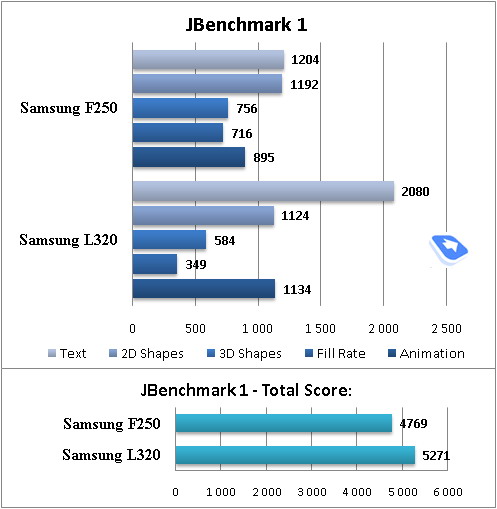
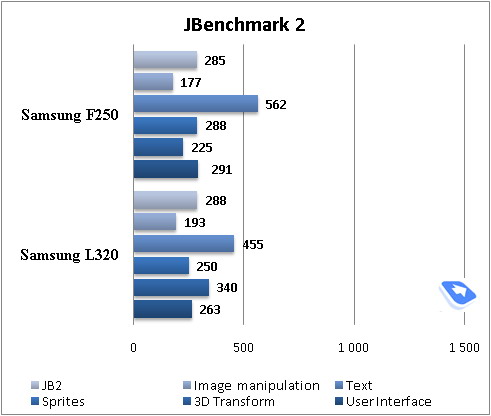
Back to the table of contents >>>
Camera
The handset comes equipped with a 1.3 Mpix CMOS camera (no auto-focus). It is quite average spec-wise – while its snaps look okay on the F250’s screen, they lose a big chunk of their quality when viewed on PC. The following resolution modes are supported:

- 1280x1024 pixels
- 800x600 pixels
- 640x480 pixels
- 320x240 pixels
- 160x120 pixels
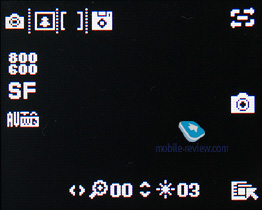
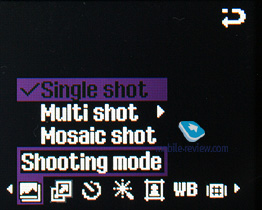
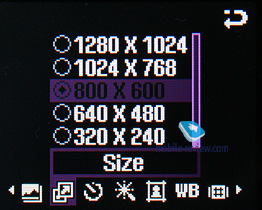
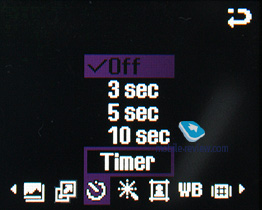
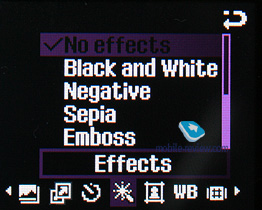
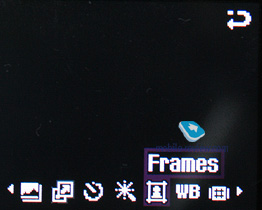
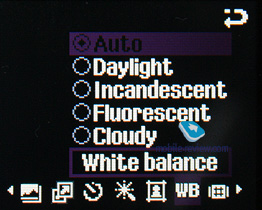
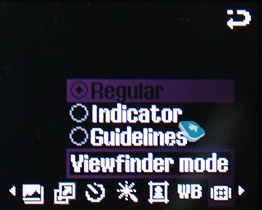
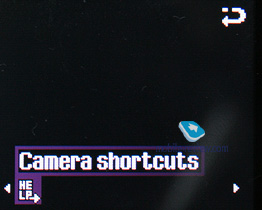
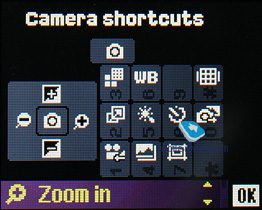
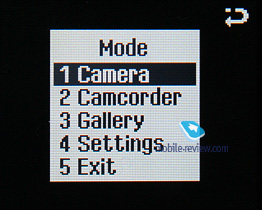
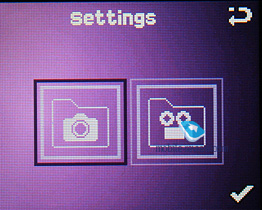
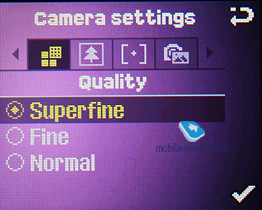
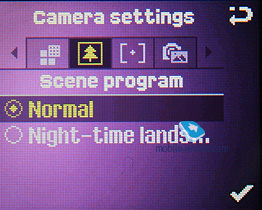
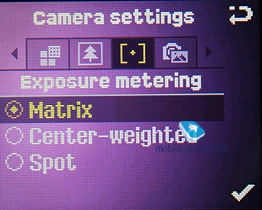
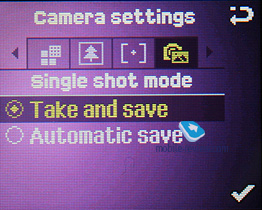
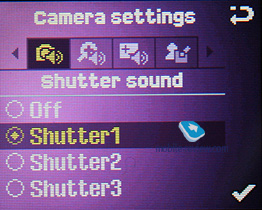
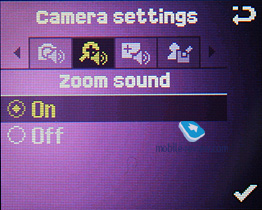
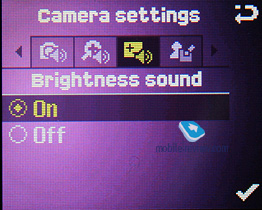
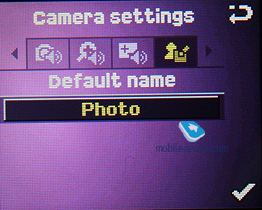
There are also three quality settings (JPEG), as well as the night mode, white balance, shutter sound on/off options, self-timer (3, 5 and 10 seconds), and an array of effects (Black&White, Negative, Sepia, Antique, Moonlight, Fog). You can also opt to shoot a series of 6 or 15 images in a rapid succession (at an adjustable interval). Plus the F250 sports the mosaic mode and an assortment of frames for your snaps..
 |
 |
| (+) maximize, 1280x1024, JPEG |
(+) maximize, 1280x1024, JPEG |
 |
 |
| (+) maximize, 1280x1024, JPEG |
(+) maximize, 1280x1024, JPEG |
 |
 |
| (+) maximize, 1280x1024, JPEG |
(+) maximize, 1280x1024, JPEG |
 |
 |
| (+) maximize, 1280x1024, JPEG |
(+) maximize, 1280x1024, JPEG |
 |
 |
| (+) maximize, 1280x1024, JPEG |
(+) maximize, 1280x1024, JPEG |
 |
 |
| (+) maximize, 1280x1024, JPEG |
(+) maximize, 1280x1024, JPEG |
 |
 |
| (+) maximize, 1280x1024, JPEG |
(+) maximize, 1280x1024, JPEG |
 |
 |
| (+) maximize, 1280x1024, JPEG |
(+) maximize, 1280x1024, JPEG |
Video can be recorded in one of the following resolutions: 176x144, 160x120 and 128x96 pixels, on top of that you can enable the MMS mode which will cap the clip’s size. The quality of the F250’s videos is quite meager, and definitely pales in compassion with contemporary solutions, where the resolutions of 240x320 pixels or even VGA are not all that rare. Video clips may be edited with help of the same set of effects and quality settings as those used for still images.
Back to the table of contents >>>
Menu
The main menu is viewed as a grid (3x4). All sub-menus have horizontal lists - in the case of there being a sub-menu, you will see a pop-up list on the right of the highlighted item. You see which items are stored underneath, and once you press OK button, you will get there. When you lean the navigation key either left or right, you will be able to access the corresponding item immediately. Ergonomics of such solution is unquestionable, as you will have to make at least one key-press less. Also you can disable this view mode, so then the F250’s menu becomes just like any other menu system.
While surfing the menus you can take advantage of last item memorization in every sub-menu and the main menu. The handset will “remember” which function you addressed last time, and will highlight it automatically next time you enter the same menu item. For example, if you had selected call list in main menu and done some operations in it, then the next time you enter main menu you will have it highlighted in first place. But that’s not all; once you access it again you will see that sub-menu item which was addressed last will be highlighted too. It seems to be a simple thing, but it is not present in handsets produced by any other manufacturer.
When hovering over one or another item in the list you will see it highlighted, and font size (which is big already) will be increased.
Shortcut number navigation is supported, but there are more ways to navigate the menu in the F250. You can bind four different applications from the list, offered by manufacturer (you will not be able to bind java applications). There is no quick launch menu available in the F250 (Living world).
The process entering menu items is accompanied by animation – there are two effects at your disposal that can be setup in the menu.
Back to the table of contents >>>
Phonebook
Contacts can be accessed by pressing right soft key; you will see a list that contains all entries from both SIM-card and phone’s memory (you can opt to view them separately, though). The field beneath the name is the default number, which can be picked manually from the list of submitted numbers for a particular contact. Quick name search by first letters is supported; there can be up to twenty of those, for any language. Once you press OK key you will go into detailed view of the selected entry. There you will see a thumbnail, if any. It can be an image, a photo or a video clip. Each entry can have up to 5 phone numbers of different types (mobile, office, home, fax other), one of them will be main number (by default it is the first one you entered). All fields are hardwired.
There are two lines for First Name and Last Name (search is performed only by the former), these fields get merged when displayed in the general list, and First Name comes first. For example Eldar Murtazin will be shown only in this order. Length of each field is 20 characters for any supported input language. You can also switch languages on the fly when entering a name.
All entries, regardless of language, are sorted out in the following way – all contacts with headings made in a local language (Russian, for example) go first and then those with names in English. This is rather convenient and handy list sorting system. Taking into account fast language switch option during the search, it’s clear that no language will spoil the experience of working with this phone. The list can also be sorted by first or last name.
But let us return to the information entered for a contact. Apart from phone numbers, e-mail address, a little text memo can be submitted on top of all that. Any music file (including MP3) can be picked as a ring tone for a contact. Three caller groups are provided by default with the possibility for creating any number of additional groups, setting a personal melody and image for each. SMS alerts are not customizable.
The phonebook is capable of holding up to 1000 contacts with filled in data fields. Even if all the available blanks are not used, the cap won’t get any bigger and will still make one thousand. It is possible to specify in the settings where all new numbers should be kept by default. There is also an option for moving entries from the SIM-card, although the reverse action is denied. According to the developers, PC (MS Outlook in particular) is best for data synchronization with the F250. Any contact in the form of SMS/MMS, mail message or other text file can be quickly sent through Bluetooth to another device. There are no problems with sending, and the phonebook entry gets beamed to another device, where it is read without any trouble.
The phonebook may contain a business card as well, though its structure copies all the fields found in a regular contact in the phone book.
There can be up to eight numbers in the fast dial list; separate numbers tied up with a single contact may appear on this list as well. The chosen entry (not of the phone number type) is displayed on the buttons as the subtitle.
You can create any number of caller groups, assign up to 20 contacts and customize them with a picture and tune.
On an incoming call, caller ID picture occupies not the entire screen, but only a part of it. When dialing you can search for entries by first digits of their numbers (what’s more, the F250 skims through both the contact list and call log). If your contact happens to be busy at the time you are calling, the handset will offer you to choose from other phone numbers stored in that entry and try them
Back to the table of contents >>>
Call log
Each of the given lists contains up to 30 phone numbers. There is a combined list of all the last calls with an icon indicating call type. Pressing the navi-pad horizontally, you can switch quickly between the lists. The date and time of the calls are displayed in the extended view for separate entries. Calls from/to one number are grouped up, so that the number standing next to the call specifies total number of calls made. In order to access duration data you will need to call up detailed information on desired item. As always, the overall time of the calls and their cost can be viewed in this menu (in the case that the service has been enabled).
For individual numbers you can arrange a black list, which will reject all calls coming from these contacts.
Back to the table of contents >>>
Messaging
Unlike Samsung’s contemporary offerings, the F250 sticks to the old scheme with SMS and MMS messages divided into separate categories. The phone memory can hold up to as many as 500 messages; the handset supports EMS standard compatible with Nokia Smart Messaging. T9 text input comes in handy and is easy to use. While choosing recipient, you can either select a telephone number from your contacts or pick one from the call lists or groups. All messages are manageable, this means you are at liberty to move a certain number to your black list, in order to make sure all messages coming from that phone number will be deleted automatically; possibility for moving messages to any own folder is also at your disposal.
There are no size restrictions set on received messages, though an outgoing message’s size is limited to 295 KB. As for additional services available with the F250, message rejection and message retrieval type options are onboard. All messages are stored in general dynamic memory, the same goes for e-mails.
The bundled e-mail client is nothing to write home about.
Also there is a useful function for sending SOS-messages – when activated, should you find yourself in an emergency, after pressing the volume key four times, the message «I am in emergency. Please help me» will be sent to contacts submitted earlier, all incoming calls from these numbers upon sending the emergency message will be picked up automatically. Recipients (not more than 5), as well as number of Repeats may be set up manually, while text of the SOS-message is not customizable.
Back to the table of contents >>>
Organizer
There can be up to 400 different events of four types (4x100) - meeting, task, anniversary and other. Day and time as well as end time of an event are indicated for each entry. Alert signal and its duration can be adjusted to your liking; repeatable events are available for setting up (repeat time is also manageable as well as the exceptions). The weekly and the monthly calendar views are very convenient with each type of the event having its own color.
Speaking of the organizer’s shortcomings, I cannot overlook the fact that when typing date and time for an event, the end time doesn’t change, which badly hurts its ease of use – other manufacturers make the due time shift automatically (by default any event takes one hour).
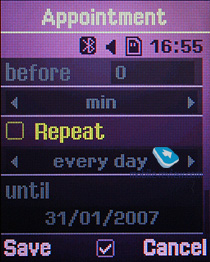
Back to the table of contents >>>
FM-radio
You can store up to 20 radio stations in the memory; the range of available frequencies is 87.5-108 MHz. Also, you can enjoy auto-tuning, but particular channels cannot have own names attached – they are always shown as the frequency numbers. The radio can work in handsfree mode, plus it enables you to set it up as an alarm clock, but regardless of how you are going to use it, a plugged-in headset is a must, since it doubles as an antenna. The radio implementation is fine, although it doesn’t pick up all stations equally well, but on balance, it is quite competent in comparison to other vendors’ offerings. The radio can be minimized.
RDS here displays only the station’s name in the general list, no advanced options available.

Back to the table of contents >>>
Applications
Voice recorder. You can record up to several hours of voice memos with the number of files being unlimited. Basically, limitations on recording duration are set by the user himself, though length of a single recording cannot exceed 1 hour. All the files are stored in a separate folder in the memory bank. The recorder performs well during lectures, conferences and presentations – I could even say that it is a partial substitute for a digital tape recorder.
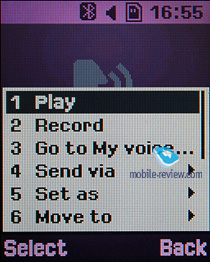
World time is displayed for two chosen cities.
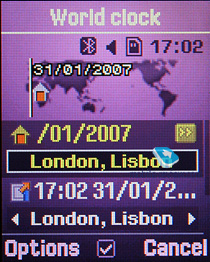
Calculator It divides, multiplies, subtracts and adds and does several more things – quite enough for a mobile calculator.
With the converter, you can operate with different units of measurements as well as with a number of currencies.
Countdown time and stopwatch have no bells and whistles.
Memo – standard text notes.
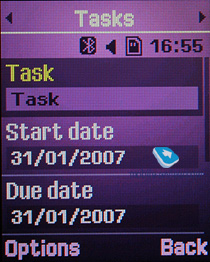
Java World. The handset comes pre-installed with 7 games, of which 3 are fully functional (Cannon Ball, Forgotten Warrior, Archangel), and four are demo-versions (limited by time or levels). These demos are quite fetching, these can be Tetris Mania, Midnight Pool, Minigolf, Poker and so on.
The memory volume assigned for Java-applications makes only 4 Mb, you can remove any of the pre-installed games at that, and upload new over the air (via WAP). Heap size can’t exceed 2 Mb, while the application can’t go over 1 Mb.
Back to the table of contents >>>
WAP
The handset comes with a wap-browser version 2.0 (NetFront 3.4), whose fundamental improvement is support for JavaScript, fonts scaling (three types), Smart-Fit (single-column view), full-screen mode (all controls are hidden), page caching. All in all, it is passable.
Back to the table of contents >>>
MP3-player
The integrated mp3 player, supporting random, sequential and cyclic playback, is available on the phone. Mp3 files can be uploaded onto the handset both directly over Bluetooth and through the synch application or Windows Media Player. There are no limitations placed on tags and names of music files. Bitrates are also not something that really matters – the handset easily deals with all available formats and supports WMA, AAC, eAAC, eAAC+.
Your tracks can be played through the stereo headset as well as the speakerphone. The volume bar has 14 scales on it. And of course the user can make up their own playlists. Player can work in minimized mode.
The F250’s sound quality is pretty good with audible bass. The menu offers “Music Recognition” service, which is a mere alternative to Sony Ericsson’s Track ID. The gist of this service is this: you record a short clip from some music track you fancy and then the phone finds you its title and artist. We bumped into no difficulties using this service with the F250.
Also, we were taken by surprise by the F250's music time – 20 hours, which is very strong statement. Living up to the bar set by the best specialist music phones from other makers, this handset comes equipped with B&O’s IceMobile amplifier. Using the music key you can call the player up in one touch, and even while at the standby screen player controls are displayed on the screen. Another great thing about the F250 is its standard 3.5 mm jack.
RightMark Audio Analyzer tests:
General performance
| Frequency response (from 40 Hz to 15 kHz), dB: |
+0.29, -2.57 | Average |
| Noise level, dB (A): |
-86.0 | Good |
| Dynamic range, dB (A): |
85.5 | Good |
| THD, %: |
7.342 | Very bad |
| IMD, %: |
2.457 | bad |
| Stereo crosstalk, dB: |
-75.3 | Very good |
| Intermodulation at 10 kHz, %: |
3.660 | bad |
General performance: Average
Frequency response

Noise level

Alexander Dembovsky’s take:
The F250’s score in our RightMark Audio Analyzer tests is nothing out of line as far as mid and low tier music playing solutions are concerned. While it looks good on the whole, its lows are crippled, starting from 100 Hz, so that you will have to employ the handset’s equalizer to rectify that and we can’t guarantee you will succeed. Also of note is the F250’s pretty low noise level, in fact with this phone Samsung have overcome the failing of all music-minded handsets. Regrettably, its IMD percentage is far from perfect, meaning that there is a ton of distortions in its sound, hence the F250’s score.
The output signal level of the F250 is pretty decent; it is better to use one of those ever-popular affordable noise-isolating earbuds, along the lines of the Creative EP630 or Sennheiser CX300.
Alarm clock. The handset comes equipped with four alarm clocks, each of them can go off on certain weekdays. You can also pick one of the five tunes, or turn to MP3 tracks. In settings it is possible to enable auto power-up whenever some event triggers off.
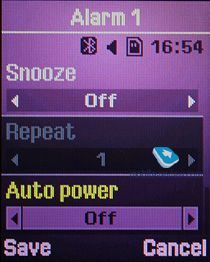
File Manager (My files). That’s the place to search for all files such as music, pictures, video and sounds. Any uploaded file gets stored here. The disadvantage is that files sometimes are not displayed in the list immediately - in that case you will need to leave the menu and enter it again.
Files and folders can be viewed either as a list or thumbnails. You can mark any number of files. The handset supports Move, Copy and Delete operations, as well as various types of sorting (by type, name or size).
Memory card’s file structure is a slightly different story, as it can be accessed through the main menu, where each item features “Memory card” option.
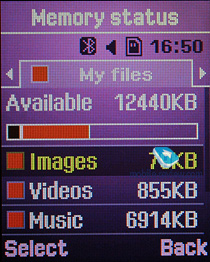
Back to the table of contents >>>
Settings. Traditionally this item boasts a standard set of options inside like password protection of selected sections (messages, short messages, organizer, etc.), backlighting duration and brightness, dialing display settings.
Profiles – this menu allows the user to setup all sound notifications and alerts of the F250 and pick the most relevant profile for current situation.
Keypad light – there are three options at your disposal, one of them is Night mode, implying that backlighting will be active only between 5:00 PM and 9:00 AM and disabled during daytime. If you come to think of it, this feature is nothing more but an illusive replacement for ambient light indicator, which Motorola’s handsets are armed with.
Setup wizard – allows adjust and tuning the handset’s main options upon startup (date, time, theme etc), though it is readily available from the settings menu.
Mobile Tracker – submit a phone number, where notifications will be sent to in case SIM-card was changed – that message will contain number of the SIM-card being used with the handset. This section is protected with password, so that no one other than you or someone else who knows the password could disable the Tracker. Should your device have the SIM-card switched once, the specified number will receive one message instantly, and one more each time a new card is plugged in. A fetching feature which can prove to be of much help in case the handset is lost or stolen.
Apart from standard wallpapers for the standby mode, you can opt for a slideshow composed of the preinstalled pictures that will pop up in random order.

Back to the table of contents >>>
Impressions
The reception quality put up by the F250 is in line with other Samsung-branded devices. The ringtone volume is quite decent, as it can be heard in various environments. The silent alert is average strength-wise, no significant improvements have been made here.
With its price tag of 220 USD (150 Euro), the F250’s only direct rival is the Nokia 5300. However, in view of the reasons we listed at the beginning of this write-up, these two are not of one breed and on top of that they target different audiences. The F250 is a potent music-minded solution if you are not heavy on bells and whistles and use your own headphones. But at the same time, it doesn’t seem particularly feature-rich in its own class given its weedy implementation of Java, entry-level camera and functionality that hasn’t gone beyond standard feats and abilities. The main thing about the F250 is its no-nonsense unfussy design that can attract and repulse many at the same time, and a slew of color schemes. On balance, it is a somewhat overpriced budget offering, but by and large given the lack of direct competition is still pretty interesting. It is quite another matter, though, that consumers who are in the market for an affordable slider are very likely to set their eyes on other solutions that look smoother and go for less at that. But as far as Samsung’s line-up is concerned, the F250 is supposed to have this segment covered.
Related links:
Back to the table of contents >>>
Eldar Murtazin (eldar@mobile-review.com)
Translated by Oleg Kononosov (oleg.kononosov@mobile-review.com)
Published — 29 April 2008
Have something to add?! Write us... eldar@mobile-review.com
|



























































